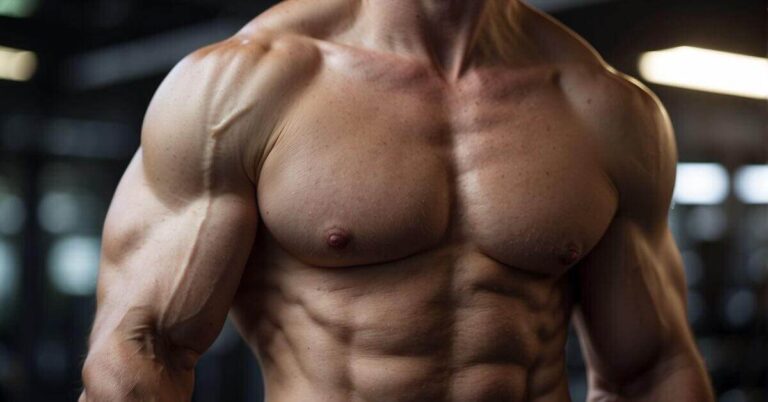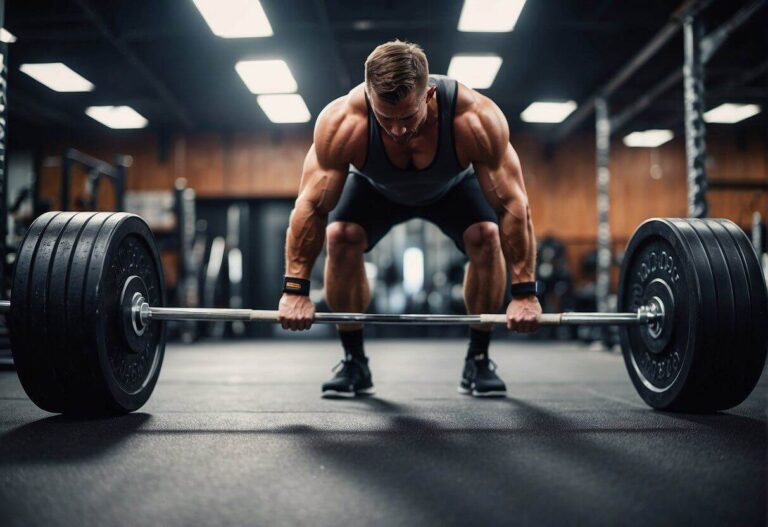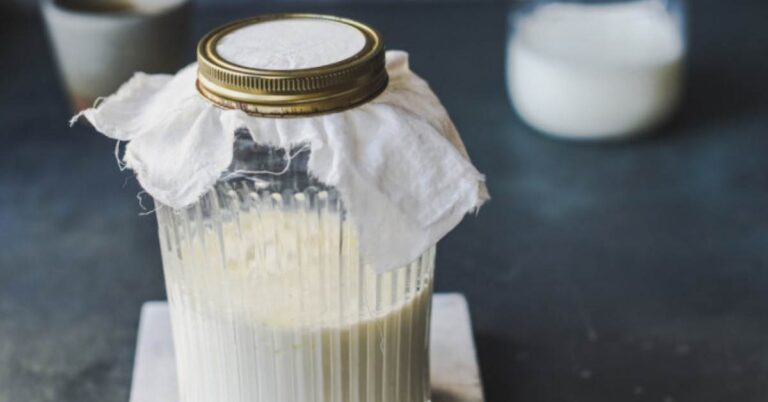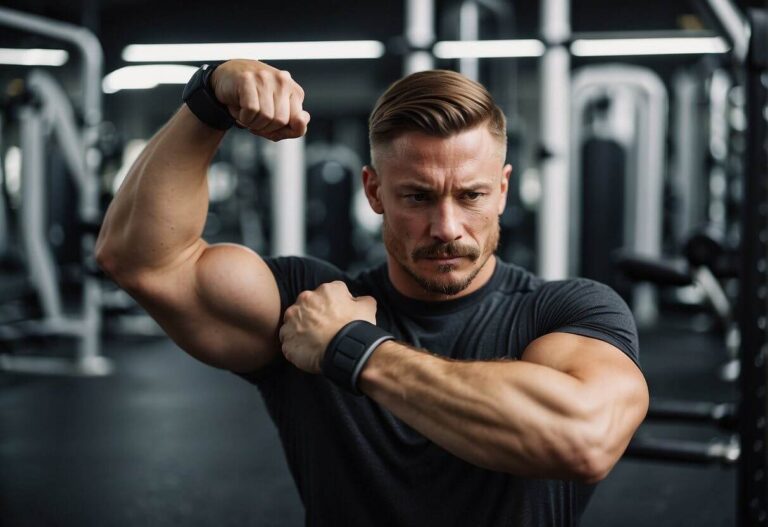Have you ever stood in front of the mirror, lifting your shirt looking for your abs? You take a deep breath and suck your stomach in and tense your stomach, hoping to see some form of a 6-pack. Yep, we’ve all done it!
Having a 6-pack is seen as a ‘trophy’ of the fitness world. The dream of having a sculpted stomach is probably the biggest goal for a lot of people. One that they chase with a mix of excitement and frustration.
Now, if you’ve read anything at all about muscle building, fitness, or the gym world, you’ve probably heard of creatine. It’s probably the most common gym supplement around.
Creatine is well-known for its ability to help build muscle and enhance workout performance, but can it really help carve out those washboard abs you’ve been working so hard for?
Let’s see if it’s the missing piece in your 6-pack puzzle. Grab a protein shake, get comfortable, and let’s talk about what creatine can (and can’t) do for your abs.
Background on Creatine
Have you ever wondered what creatine actually is and how it works? Let’s get to the point; creatine is a naturally occurring amino acid found in your body, particularly in muscle cells.
It’s renowned for boosting athletic performance and energy levels during high-intensity activities.
The Role of Creatine in Energy Production
How does creatine function? Well, in the world of nutrition and supplements, it’s a bit of a celebrity for its role in producing adenosine triphosphate (ATP). ATP is like your muscles’ currency for energy.
When you sprint or lift weights, your body uses ATP for that quick burst of energy.
Creatine’s Popularity in Muscle Endurance and Strength
Creatine is often taken as a supplement by athletes and gym enthusiasts aiming to increase muscle mass and improve recovery between intense workouts. Have you ever tried creatine supplements yourself?
They’re widely available and can be a convenient way to ensure you’re getting enough, especially if your diet might not meet your body’s demands.
While some may think that popping a creatine supplement will give them a defined 6-pack, it’s important to remember that no supplement can replace disciplined training and nutrition.
It aids your energy levels during workouts, which can contribute to more effective training sessions – think more reps or heavier lifts.
Interestingly, while it’s a supplement linked with weightlifting and sprinting, research indicates that creatine might also assist with endurance and hyperhydration.
Natural Sources and Supplement Forms
While our bodies produce creatine, we can also get it from foods like red meat and fish. However, the amounts in food are much less than what’s typically used in studies that show performance benefits, which is why many turn to supplements. These supplements come in various forms, such as creatine monohydrate, which is the most researched and widely used.
Remember, the key to any supplementation is understanding its role in your fitness journey. It’s about how the science of creatine matches your body’s needs and workout routine, rather than simply expecting miracles. So, could creatine be the extra push you need for your workouts? It’s something to think about next time you’re considering your athletic nutrition arsenal.
Creatine and Muscle Mass
Creatine is renowned for its role in improving muscle mass and strength, particularly when used alongside an effective workout routine. Here’s insight into how creatine can support muscle growth and how nutrition plays a role in its optimisation.
Benefits of Creatine for Muscle Growth
Creatine supplies your muscles with the energy needed for high-intensity, short-duration exercises like weightlifting and sprint training. This energy boost can help you manage those extra reps and sets in your resistance training, which is crucial for gaining muscle mass.
When your muscles are able to work harder due to creatine supplementation, you lay the foundations for increased strength and lean muscle mass.
A key piece of the puzzle is how creatine aids your muscle cells in retaining water, which not only makes muscles appear fuller but also can contribute to muscle growth.
Combined with protein powder in a post-workout protein shake, creatine can enhance your muscles’ repair and growth processes.
Real-world evidence from a review of 35 studies underscores that creatine is effective at increasing both muscle mass and strength, though it’s not a shortcut to a defined six-pack abs on its own.
Optimising Creatine Absorption with Nutrition
To get the most out of creatine, it’s essential to consider your overall nutrition. Consuming adequate carbs and protein in your diet can significantly enhance creatine absorption.
Carbs help to spike insulin levels, which in turn helps move creatine into muscle cells.
This is why a protein shake with added carbs is so often recommended post-workout, facilitating not just muscle recovery and growth but also the uptake of creatine by muscle tissues.
Strategic nutrition timing can be just as important as the workout itself for those seeking gains in muscle mass.
Emphasising protein-rich foods and complex carbs around your training sessions will make sure your muscles have the building blocks they need for growth, and creatine is fully utilised.
Remember, while creatine can assist in achieving strength and muscle mass, it’s the synergy with your diet and resistance training that will determine your overall success.
Creatine and Body Fat
When considering supplements to support fitness goals, it’s essential to understand how they work with your body. In the case of creatine, it’s not just about energy for workouts but also how it interacts with your body fat and weight loss efforts.

Creatine’s Role in Fat Loss and Lean Mass
Have you ever wondered whether creatine could be the secret to shedding that stubborn belly fat and revealing your lower abs? Let’s unpack some common misconceptions.
Despite what many might think, creatine doesn’t directly contribute to fat loss. However, it’s a popular supplement for those looking to improve their strength training and boost their workout recovery, which can be instrumental in building lean mass.
But how does that relate to fat loss? Well, when you increase your lean muscle through exercises like High-intensity interval training (HIIT) and strength training, your metabolic rate gets a hike.
More muscle means you’re burning more calories, even at rest, contributing to an increased energy expenditure.
That’s the key—creatine helps in retaining and building muscle, which indirectly supports your fat loss journey by improving the efficiency of your workouts and recovery.
You might be thinking, “So, will creatine help define my abs?” It’s not the creatine itself, but the way your body becomes more efficient during workouts and the subsequent muscle you gain that may help reduce stored body fat.
For those who integrate proper diet and nutrition—focusing on a caloric deficit—and pair it with consistent exercise, including cardio and strength workouts, creatine can be a supportive ally in the quest for a leaner midsection.
Remember, there’s no magical pill for weight loss or achieving a 6-pack; it’s about a combination of diet, exercise, and lifestyle choices.
So, if you’re considering creatine, it’s a tool in your arsenal, one that needs to be combined with a proper diet and a solid workout regimen.
Always keep in mind, especially when wading through a sea of fat loss myths, that no supplement—including creatine—will do the work for you. But if you’re looking for that extra edge in your workouts, creatine might just be the helping hand you need.
Diet and Exercise
Unlocking the secret to prominent abs requires a blend of strategic dieting and rigorous exercise. Let’s explore how to effectively manage your macronutrients and the pivotal role of diet, followed by diving into various exercises to optimise your fitness regimen.
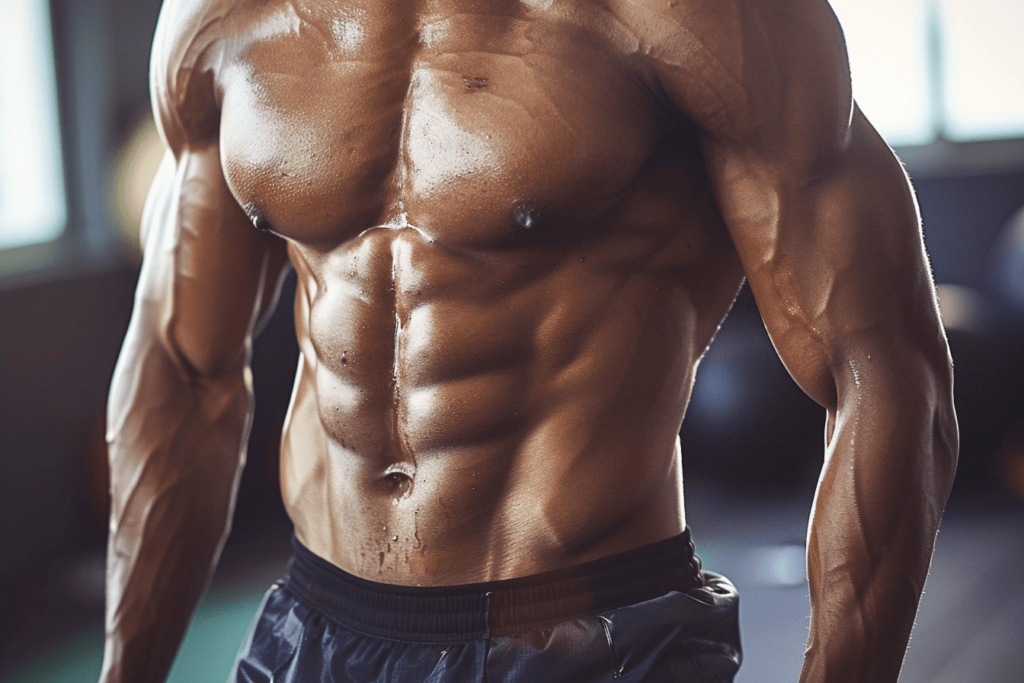
Macronutrients and Their Role in Fitness
Macronutrients are the cornerstone of any fitness journey. You’ve got your proteins, which are crucial for muscle repair, your carbohydrates for energy, and fats for vital bodily functions.
Achieving the right macronutrient balance is crucial; it’s about fuelling your workouts and recovering efficiently. Consistently consume lean protein like chicken or fish, integrate whole grains for complex carbs, and don’t shy away from healthy fats found in nuts and seeds.
Importance of Diet in Workout Regimes
Remember, you can’t out-train a bad diet. Attaining a caloric deficit is a methodical approach to fat loss strategies, yet it’s essential to pair this with healthy eating to maintain energy and muscle mass.
Plan your nutrition carefully, incorporating plenty of vegetables, fruit, and hydration to maximise results. Good sleep and rest also play a vital role in this equation, impacting everything from your metabolism to your willpower.
Exercise Varieties for Overall Fitness
Exercise is just as vital, with a mix of strength, cardiovascular exercise, and compound exercises proving to be most effective.
Your routine should include abdominal exercises but don’t forget other muscle groups; full-body workouts contribute to a stronger core and improved muscular symmetry.
Consistent training is key, whether it’s hitting the gym for weight training or going for a run to boost your cardio. Remember, regular workouts support not just muscle growth but also enhance overall fitness and health.
Potential Water Retention
When you embark on your journey to achieve a chiselled 6-pack, you might consider the popular supplement creatine for its benefits in muscle hydration and cell volumization. However, it’s essential to understand that along with its muscle-boosting potential, creatine may cause water retention, particularly during the initial loading phase.
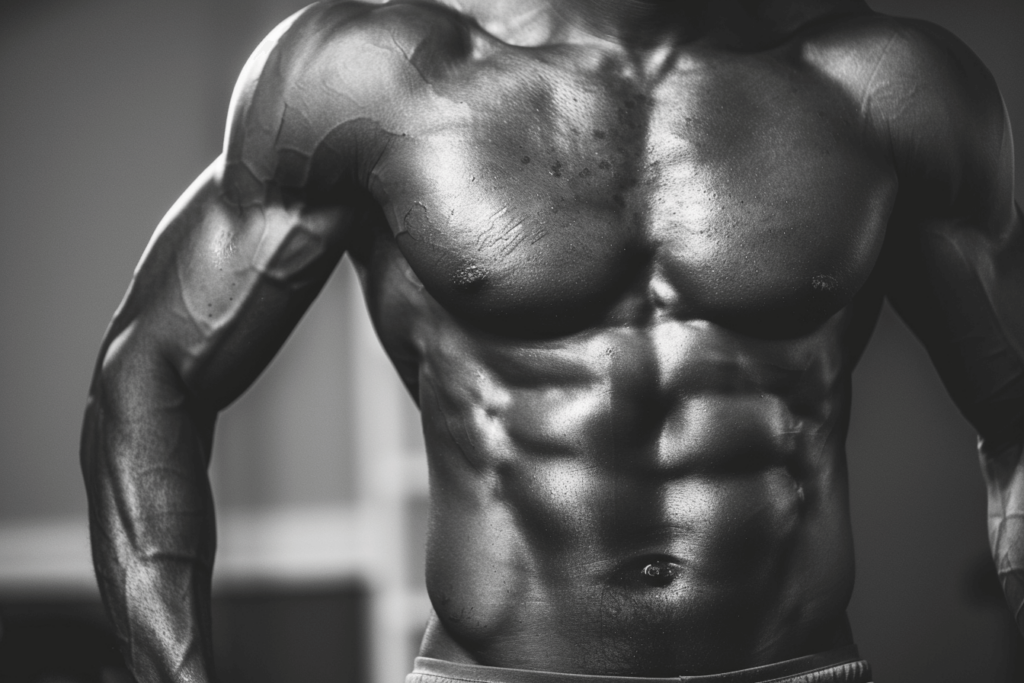
During this phase, your muscles soak up more water than usual, enhancing the size and volume due to cell volumization. While this can initially inflate the scale, causing some weight fluctuations, don’t be disheartened. This isn’t indicative of fat gain but rather an increase in muscle hydration.
Now, you might wonder if this additional water could hinder the visibility of your abs?
It is indeed possible that creatine can lead to a modest increase in subcutaneous water, which may blur that abdominal definition you’re working hard to reveal. Discussions on forums like Bodybuilding.com and Reddit illustrate varied experiences with this.
To manage bloat and maintain an optimal electrolyte balance, consider these tips:
- Hydrate efficiently: Drinking plenty of water ensures proper muscle function and might counteract the puffiness by encouraging your body to expel excess fluids.
- Monitor your intake: Gradually increasing your creatine intake to find the right balance for your body can minimise bloating.
Keep in mind, regulating these effects takes a bit of trial and error. Stay patient and assess your body’s response. As the water retention stabilises, you should observe a clearer definition visibility while still reaping the hydration benefits creatine provides for your muscles.
Will Creatine Help Me Get a 6-Pack?
So what’s the answer?
Firstly, creatine is a supplement that may aid in improving your performance during high-intensity workouts. This potentially leads to an increase in muscle mass and strength.
So, pumping iron at the gym? Creatine can be your ally by supporting those extra few reps.
However, when it comes to unveiling a 6-pack, the narrative focuses chiefly on your body fat percentage. You need a balanced diet alongside regular training to reduce body fat, which in turn might reveal your abs underneath.
The combination of a proper diet and supplementation is crucial. While creatine helps with muscle contraction, it doesn’t directly burn fat.
Thus, your 6-pack success won’t be solely dependent on supplementation.
Setting realistic expectations is also key. Achieving a 6-pack will take time and requires dedication both in and out of the gym.
Remember, a 6-pack is not only aesthetically pleasing, but is also indicative of long-term health and fitness.
When aligning with achievable goals, always consider your personal health background and fitness level. It’s vital to remember that results will vary based on individual body types and metabolic rates.
In essence, while creatine can support your muscle building and workout performance, it’s not a magic ingredient for fat loss.
Factors Influencing Six-Pack Development
Achieving washboard abs is not just about crunches and planks; it’s a multi-faceted approach that includes understanding your body fat percentage and how it plays a crucial role.
- Body Fat: To reveal your abs, you’ll need to reduce your body fat to a certain level. Men typically start to see their six-pack when they dip below 14% body fat, with a more defined look at under 10%, while women may need to aim for below 20%.
- Abdominal Muscles: The rectus abdominis is the muscle responsible for the coveted six-pack. But, it’s not just about this one muscle; your entire core counts, including the obliques and lower back muscles.
- Genetics: Your genes can influence the shape of your abdominal muscles and how easily you can reduce body fat in your midsection.
- Diet: Eating nutritiously with a focus on lean protein, vegetables, and whole grains, and maintaining a caloric deficit is essential.
- Exercise: A combination of weight training, cardiovascular activities, and specific exercises targeting the core muscles will boost muscle growth and fat loss.
Remember, it’s a blend of shedding fat and building muscle. Hit the weights, do your cardio, and keep your nutrition in check. It’s not going to happen overnight, but with consistency, you’re certain to get there.
For more information and tips, take a look at this video:


